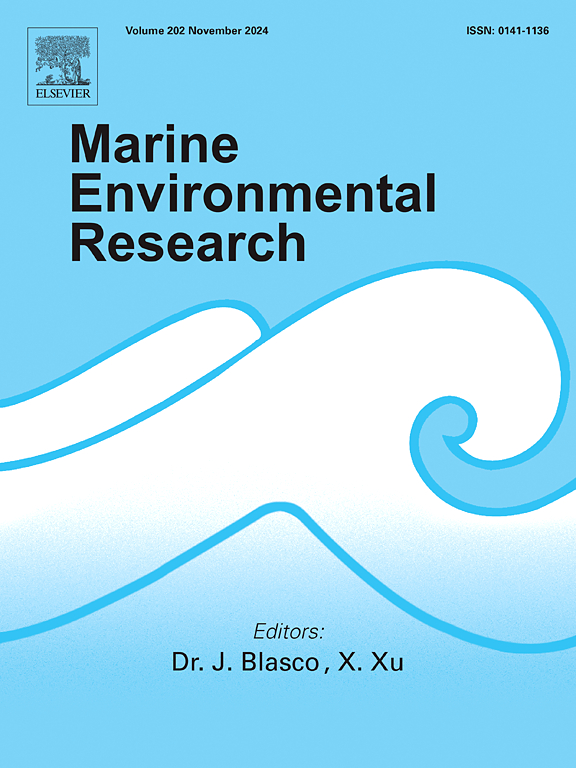冷应激通过改变氧化、代谢和免疫反应破坏黄鳍金枪鱼幼鱼鳃的稳态
IF 3.2
3区 环境科学与生态学
Q2 ENVIRONMENTAL SCIENCES
引用次数: 0
摘要
急性冷应激可以破坏海洋鱼类的生理稳态,并可能引起具有区域吸热能力的中上层鱼类(如黄鳍金枪鱼)的显著代谢和免疫反应。鳃作为与环境连接的关键组织,在气体交换、离子调节、免疫防御和能量代谢等方面发挥着重要作用,因此极易受到热波动的影响。本研究采用低温(24°C)和低温(18°C)两个处理组,并以低温(30°C)为对照组,研究了黄鳍金枪鱼幼鱼在急性冷应激下鳃组织的生理反应。在0、12、24和36 h进行采样,以评估抗氧化和代谢酶活性、组织病理学改变以及免疫和代谢相关基因的表达。结果显示抗氧化酶(SOD, CAT, POD, GSH-Px)随时间变化,MDA和LPO水平在12 h和24 h显著升高(p <;0.05),特别是在18°C下,表明氧化应激加剧。AST、LDH、ACP和AKP的显著变化提示代谢重编程和膜功能改变。Na+/K+-ATPase和Ca2+/Mg2+-ATPase活性的变化反映了热胁迫下的离子调节。hspa8b、热休克同源蛋白71kda、irf3、lpl和pck2的基因表达表现出温度和时间依赖的适应性反应。组织学分析显示随着温度的降低,进行性水肿、坏死和板层断裂。总的来说,这些发现突出了黄鳍金枪鱼鳃组织在寒冷暴露下的多层应激反应,并为中上层物种的热适应和耐寒养殖策略提供了新的见解。本文章由计算机程序翻译,如有差异,请以英文原文为准。

Cold stress disrupts gill homeostasis in juvenile yellowfin tuna (Thunnus albacares) by altering oxidative, metabolic, and immune responses
Acute cold stress can disrupt physiological homeostasis in marine fish and may induce pronounced metabolic and immune responses in pelagic species such as yellowfin tuna (Thunnus albacares), which possess regional endothermic capabilities. As a key tissue interfacing with the environment, the gill plays essential roles in gas exchange, ion regulation, immune defense, and energy metabolism, making it highly susceptible to thermal fluctuations. This study investigated the physiological responses of gill tissue in juvenile yellowfin tuna under acute cold stress, using two treatment groups—LT (24 °C) and ULT (18 °C)—with a control group (CG, 30 °C). Sampling was conducted at 0, 12, 24, and 36 h to assess antioxidant and metabolic enzyme activities, histopathological alterations, and the expression of immune- and metabolism-related genes. Results showed time-dependent changes in antioxidant enzymes (SOD, CAT, POD, GSH-Px), with significantly elevated MDA and LPO levels at 12 h and 24 h (p < 0.05), especially under 18 °C, indicating intensified oxidative stress. Significant alterations in AST, LDH, ACP, and AKP suggested metabolic reprogramming and membrane function changes. Variations in Na+/K+-ATPase and Ca2+/Mg2+-ATPase activity reflected ion regulation under thermal stress. Gene expression of hspa8b, heat shock cognate 71 kDa protein, irf3, lpl, and pck2 demonstrated temperature- and time-dependent adaptive responses. Histological analysis revealed progressive edema, necrosis, and lamellar disruption with decreasing temperature. Collectively, these findings highlight a multilayered stress response in yellowfin tuna gill tissue under cold exposure and provide new insights into thermal adaptation and cold-tolerant aquaculture strategies for pelagic species.
求助全文
通过发布文献求助,成功后即可免费获取论文全文。
去求助
来源期刊

Marine environmental research
环境科学-毒理学
CiteScore
5.90
自引率
3.00%
发文量
217
审稿时长
46 days
期刊介绍:
Marine Environmental Research publishes original research papers on chemical, physical, and biological interactions in the oceans and coastal waters. The journal serves as a forum for new information on biology, chemistry, and toxicology and syntheses that advance understanding of marine environmental processes.
Submission of multidisciplinary studies is encouraged. Studies that utilize experimental approaches to clarify the roles of anthropogenic and natural causes of changes in marine ecosystems are especially welcome, as are those studies that represent new developments of a theoretical or conceptual aspect of marine science. All papers published in this journal are reviewed by qualified peers prior to acceptance and publication. Examples of topics considered to be appropriate for the journal include, but are not limited to, the following:
– The extent, persistence, and consequences of change and the recovery from such change in natural marine systems
– The biochemical, physiological, and ecological consequences of contaminants to marine organisms and ecosystems
– The biogeochemistry of naturally occurring and anthropogenic substances
– Models that describe and predict the above processes
– Monitoring studies, to the extent that their results provide new information on functional processes
– Methodological papers describing improved quantitative techniques for the marine sciences.
 求助内容:
求助内容: 应助结果提醒方式:
应助结果提醒方式:


